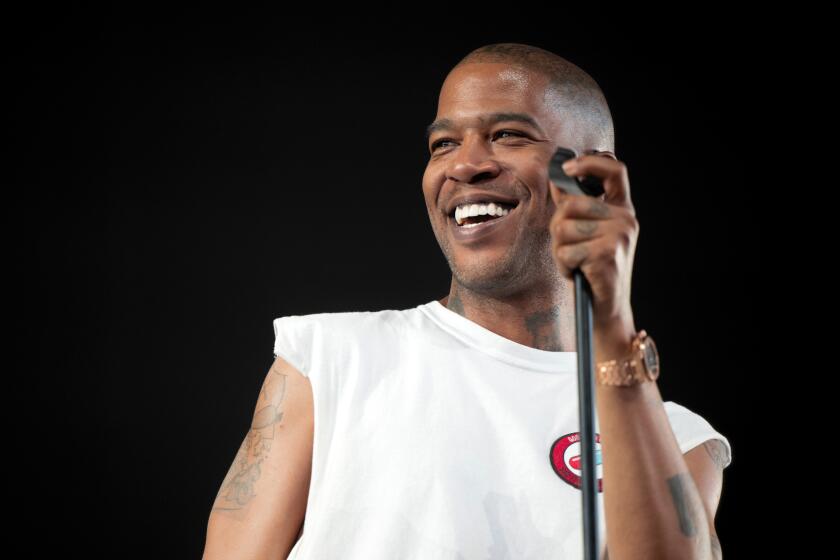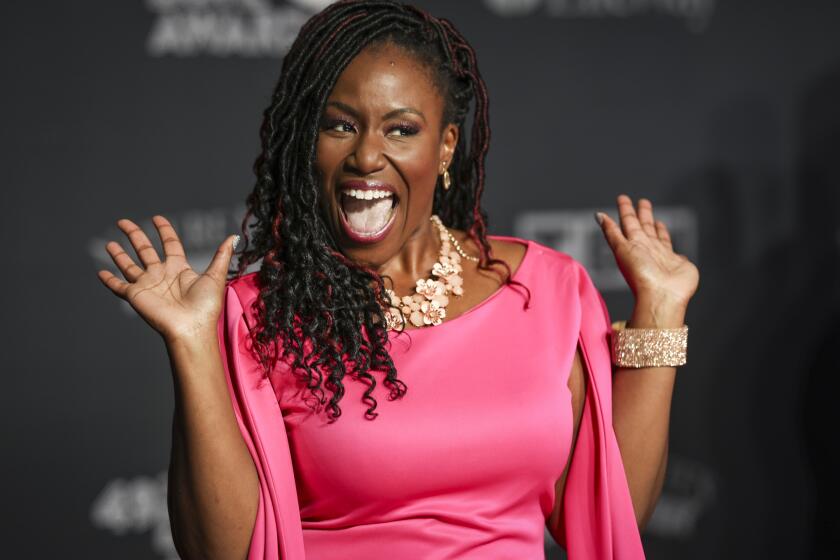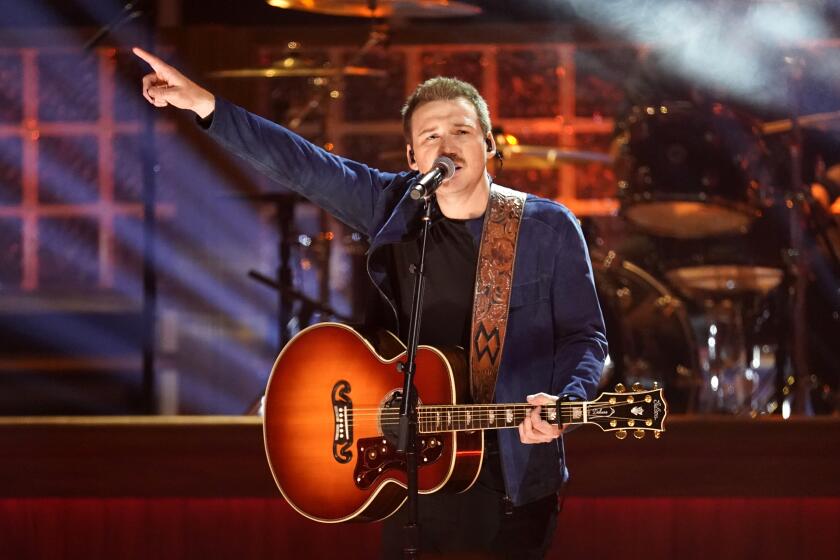Video: Pop duo YACHT talks about yellow film location signs and visual language in ‘L.A. Plays Itself’
When the Los Angeles dance pop duo YACHT relocated to Los Angeles from Portland, Ore., and started learning the language of the city, they immediately noticed the yellow production signs that most residents by this point ignore. Festooned to poles across the region, the signs direct film and TV crews to the day’s locations and are a common sight for anyone who’s lived in the Los Angeles area for any length of time.
The pair, Claire L. Evans and Jona Bechtolt, incorporated these placards into the video to “L.A. Plays Itself,” which The Times is premiering below. A love letter to both the city and to “Los Angeles Plays Itself,” the four-hour documentary about its history in film, the clip roams neighborhoods, cruising by signs upon which the band has printed the lyrics to the song.
This isn’t the first mash note that the YACHT singers have composed to their adopted city. They’re also responsible for the excellent smartphone app 5 Every Day, which offers tips on cultural events happening in the city (specifically, five of them every day).
See the most-read entertainment stories >>
But we’re focused on those yellow signs and their place in the city. Taken from the forthcoming album, “I Thought the Future Would Be Cooler,” (out Oct. 16 via Downtown Records) the track features YACHT’s trademark propellant drive and thoughtfully considered lyrics.
Watch the clip, which was directed by Los Angeles filmmaker David Lawrence and YACHT, below. That’s followed by the duo’s fascinating thoughts on Los Angeles as a setting and location — as well as the means by which the group rigged Uber’s surge-pricing algorithm in service of the video.
Los Angeles Times: Talk about the genesis of “L.A. Plays Itself.”
Jona Bechtolt: We’ve lived in Los Angeles for about four years, and after living here for a few months, we started noticing production signs all around town for different filming locations. And it was so interesting that they were uniform, that every single sign was exactly the same no matter what part of town you were in.
It came to us initially as an idea to do a text-based poem using location signs. But we got this opportunity to take over the Getty for their Friday Flights series, and we were like, “Oh, that’s perfect. Let’s do this.” It was a weird joining of forces. Our album was completed around the time that we got the Getty offer, so then we thought, “This should be for one of the songs, a song that we wrote about Los Angeles.” It made perfect sense. The stars aligned and the idea was born for it to be the lyrics of the song.
Claire L. Evans: Also, we learned about what those signs were all about from the documentary “Los Angeles Plays Itself.” It made a lot of sense to us. One of the things that we really love about living in Los Angeles you have access to the means of production more than in other cities, at least in our experience. So when you see something like those signs, it’s like a mystery that you can get to the bottom of, and because they’re so uniform, we realized they all must come from the same place.
JB: We dug around and found a KPCC story. They’re called JCL America.
CLE: One company makes them for every production in Los Angeles. They have the market cornered on these signs. They’re completely standardized, utilitarian signs.
JB: And what was interesting to us about the lyrics was with a lot of these production companies, they either truncate or rename themselves to fit on the signs. So when we used larger words in the lyrics, they skew them in this really fun way that other printing people would never do. Graphic designers would never squish a word the way these guys squish words. When you put them all together, they look so amazing to us.
CLE: We’re really into vernacular type, and one of our favorite things, also, about living in L.A. is the wide diversity of hand-painted signs — the visual language of the city. Which is what the song is about — these production signs, which are really ugly in a specific way, and are utilitarian. The type is utilitarian and the only consideration that’s made is, “Is this as bright as possible? Is it waterproof?” It’s so practical, and that makes the type really interesting. So for us, visually, it does a lot when they’re all together.
JB: And we’re eternal optimists, too, so when we see a sign on the street we’re like, “What is the end-game for that sign? What is the best possible scenario?” And showing those signs at the Getty was —
CLE: — the elevation at the Getty of the L.A. street vernacular into a really rarified space, like a museum, or in a music video that gets distributed all over the country or the world.
I’m interested to see whether people outside of Los Angeles understand what those signs are. I think not. We were trying to explain the concept to people in New York, and they don’t have those signs in New York. I mean, they have a lot of production in New York, but they have a different system.
JB: They just use paper — printouts. And I think they’re mostly pink. Just a bright pink paper printout, regular eight-and-a-half by eleven size.
CLE: For us it’s a wink. Anyone in L.A. seeing this video I hope will recognize those signs and realize it’s for us by us.
JB: I’ve never seen a lyric video — we kind of consider this a lyric video — that involves physical space and actual real signs in the real world. That was another thing that was interesting to us. It’s overwhelming to have so many shots.
CLE: You should be able to recognize just from the tone of each shot where it is in Los Angeles, what the neighborhood is. And I think it’s really interesting how immediately identifiable L.A. neighborhoods are, even if it’s a short clip.
It involved printing all the signs, hanging them individually and shooting them?
CLE: Yes.
I was wondering whether any Photoshop was involved.
CLE: No, it’s all in the world. It’s funny, we were like, “We’ll just get a sign made for every word in the song.” Turns out that’s 163 signs. Huge boxes of signs, all of which need to be tied up with baling wire, hung to a telephone pole. It was many weeks. Our director was truly long-suffering, had to drive all over the city for two weeks. Hopefully he got something good out of it.
Can you link the film “Los Angeles Plays Itself” with your song? Did you see the film and then write the song?
CLE: Absolutely. The song is explicitly inspired by “Los Angeles Plays Itself,” which we believe to be mandatory for Angelenos. The most important film ever made about Los Angeles — and it contains every other film made about Los Angeles, so it’s a real one-two punch.
One thing we find so fascinating about this city is how self-referential it is and how, when you live here, you’re totally surrounded by all these visions of the city’s presentation throughout history in film. Even if you’re new here, there’s still something familiar about it because of the light, because of the color of the sidewalks, the things that you have collectively experienced through the entire history of film and television. It’s comforting and alienating at the same time.
I just found a blog that’s gathered all of the locations used in “The Rockford Files.” While I was scrolling, it struck me that as a non-native, some of my first information about the city was learned through Jim Rockford solving crimes.
CLE: All of Los Angeles is a location in various layered ways. The reason we named the song “L.A. Plays Itself” instead of “Los Angeles Plays Itself” — two reasons. One, there’s a film called “Los Angeles Plays Itself” that’s an avant-garde gay porn from the ’70s.
JB: That’s actually what the documentary “Los Angeles Plays Itself” was named after.
CLE: We haven’t seen it because it’s really hard to see, although it’s apparently in the collection at MOMA or something.
JB: I have a torrent of it coming right now. [Laughter]
CLE: There’s a part in Thom Anderson”s documentary about the diminutive “L.A.” versus “Los Angeles” as a form of condescension. That calling Los Angeles “L.A.” is belittling, which is extremely funny to me.
JB: But it’s totally imprinted on me. After seeing the movie, now I never say “L.A.”
I’m the same way, actually. After Anderson, that declaration in the movie, I stopped saying “L.A.” And I don’t even know that I agree with it, but his argument was so convincing.
CLE: I always associated “L.A.” with a cooler, more rock ’n’ roll way of saying “Los Angeles.” But anyway, naming the song “L.A. Plays Itself” was kind of a wink to that. Our song is diminutive to this four-hour epic documentary.
What was the Uber aspect of this project? A stream of the song was unlocked for early viewing whenever surge pricing went into effect?
CLE: Well, basically we treat every one of our songs like an opportunity to do interesting on- and off-screen projects and experiences. We’re both designers. I’m a writer. For us, music is a great jumping-off point for all kinds of other interesting things.
JB: And we see each song as having its own complete identity, to be powerful enough to tell its own story across all media.
CLE: Being in a band is an amazing opportunity to do things. You have material. We wanted to something with “L.A. Plays Itself” that would speak to what the song was about and would be a direct connection to the city of Los Angeles. We wanted L.A., the city, to play the song, literally, so we decided to tie it to traffic patterns. Uber has a public API that — essentially it’s not about Uber for us as much as Uber’s API being a really good metric for traffic in L.A.
By bonding it to that, then we allow Los Angeles traffic patterns to literally play the song for viewers, and for us that’s a nice way of connecting the city to the music that inspired it.
JB: We always kind of misuse things. The Uber API isn’t meant for this.
CLE: It isn’t meant to play pop songs?
JB: It isn’t even meant to draw attention to surge pricing, which everyone … hates. Though we like bringing that to the forefront.
CLE: Try and turn a negative into a positive. This form of tracking of the city’s movements and users of the app is exploitative in that it takes us at our most vulnerable moments and charges us more when we need something more. That’s just capitalism, of course, but if we’re going to be punished for moving around the city at the same time as everybody else, at least let’s add a positive to that, you know? At least there’s a silver lining.
JB: And now they’ve reached out directly to us. This is not any sort of collaboration with Uber.
CLE: It’s a critique of Uber, if anything.
JB: After it started getting tons of press, the manager of the API, the whole team manager, contacted us and was like, “How can we do something else?”
CLE: That’s the snake eating the tail of the contemporary Internet marketplace.
This interview has been edited for clarity and length.
Follow Randall Roberts on Twitter: @liledit
The biggest entertainment stories
Get our big stories about Hollywood, film, television, music, arts, culture and more right in your inbox as soon as they publish.
You may occasionally receive promotional content from the Los Angeles Times.




